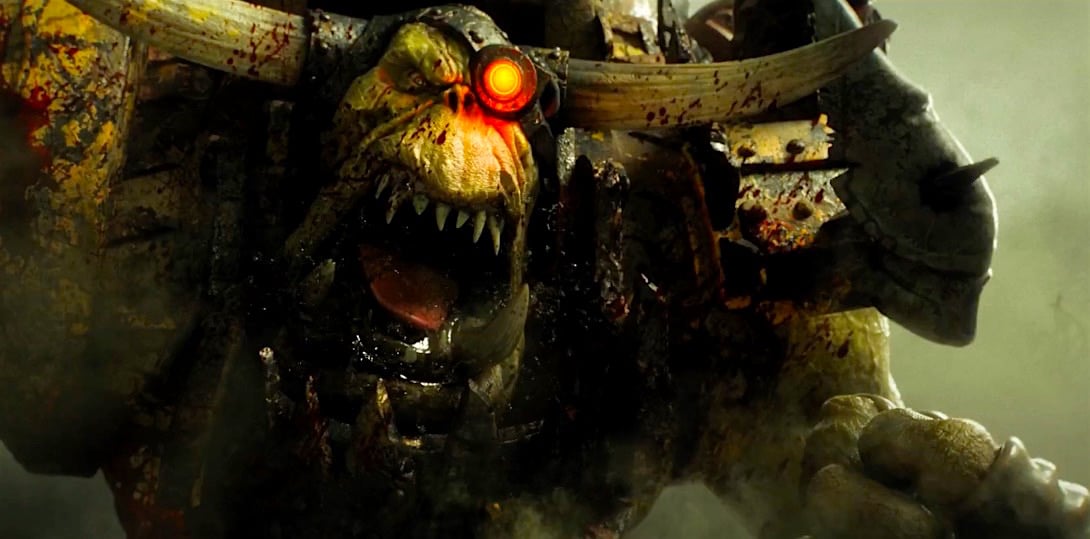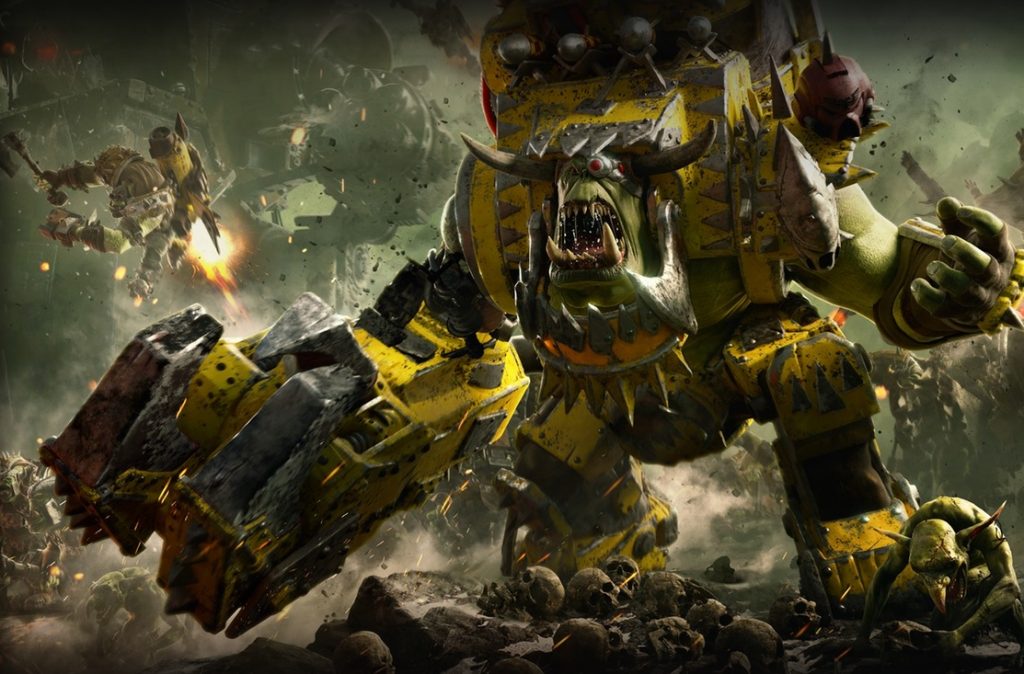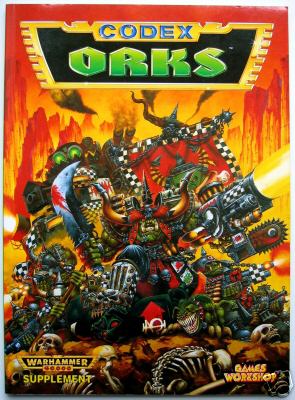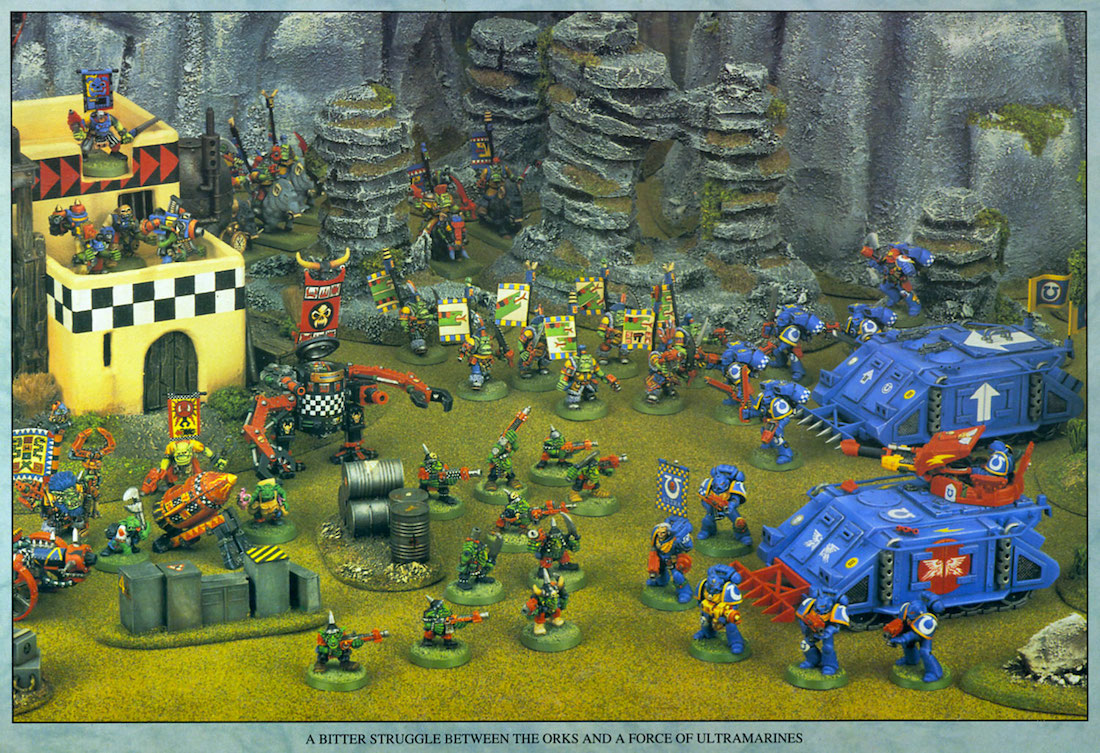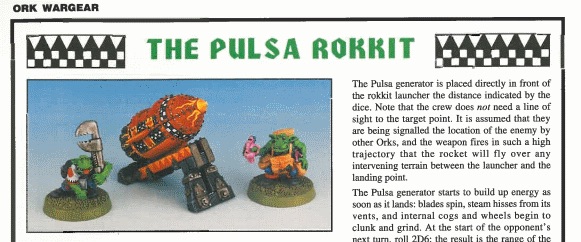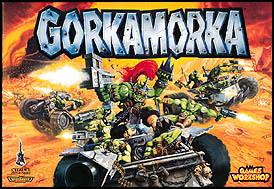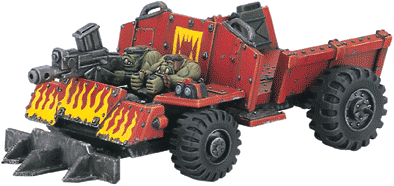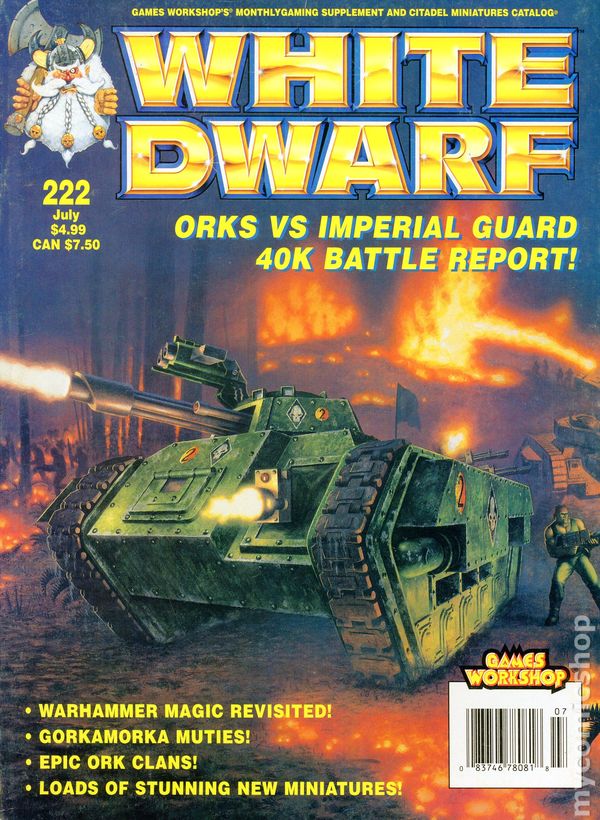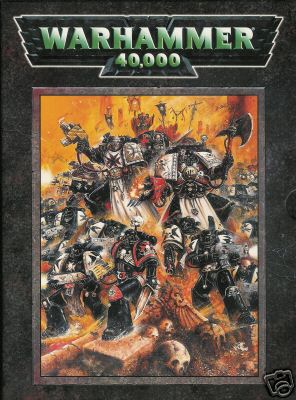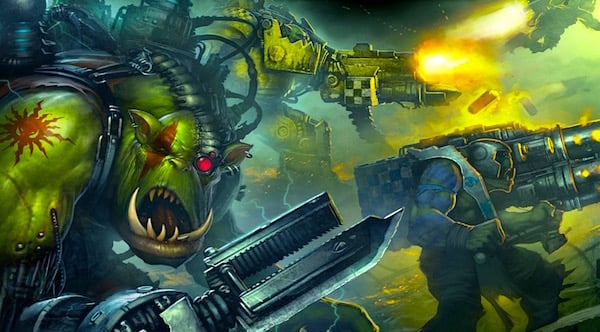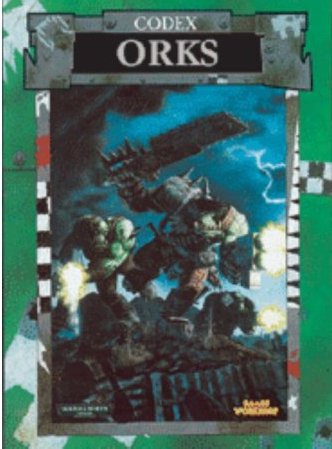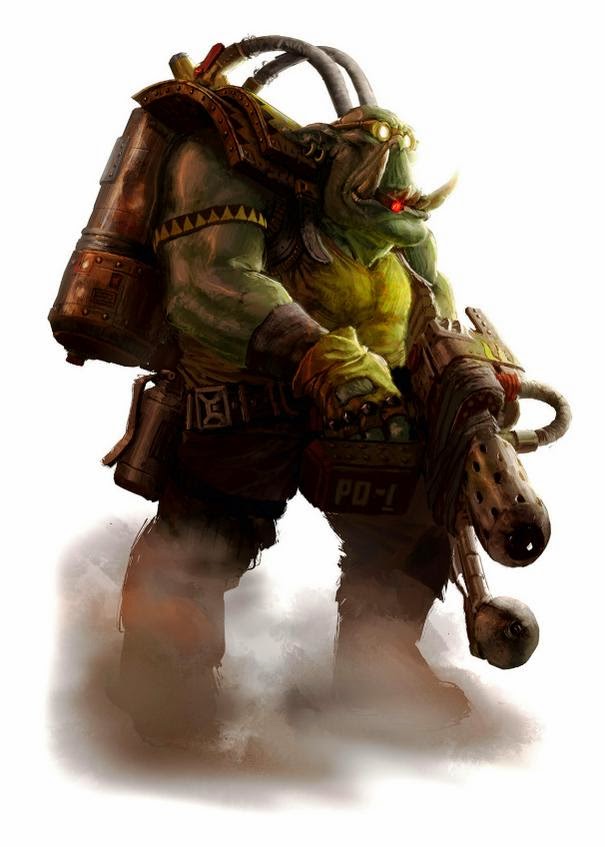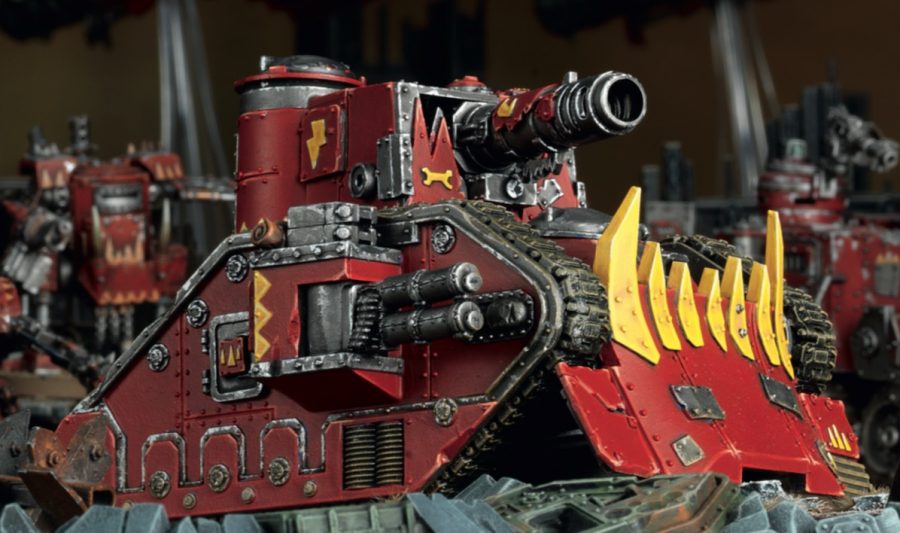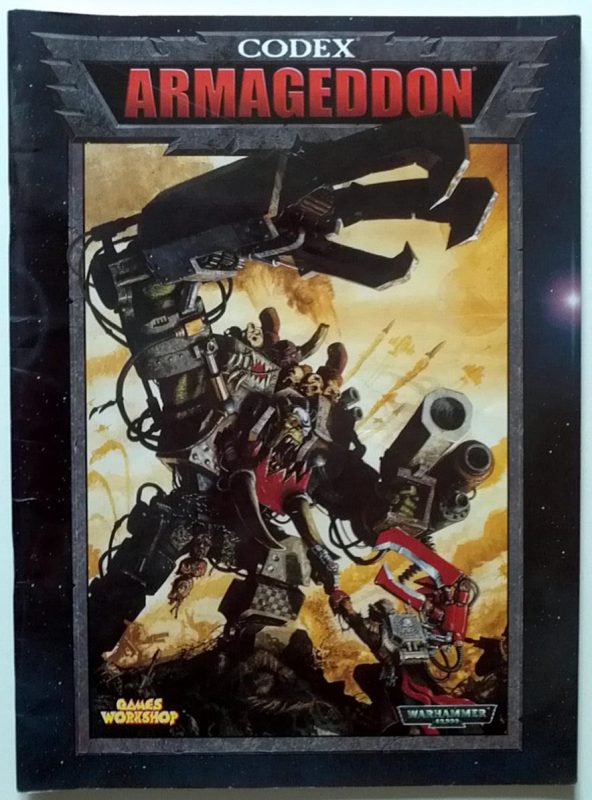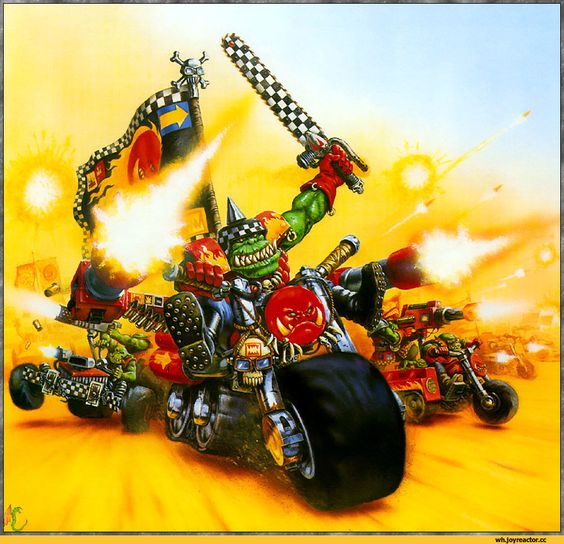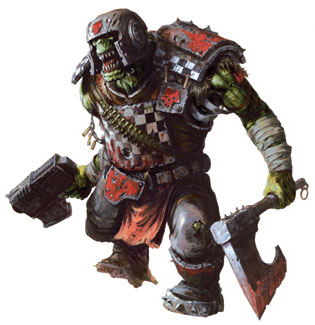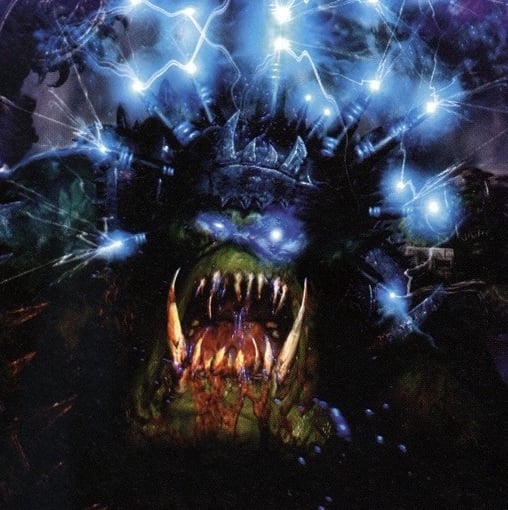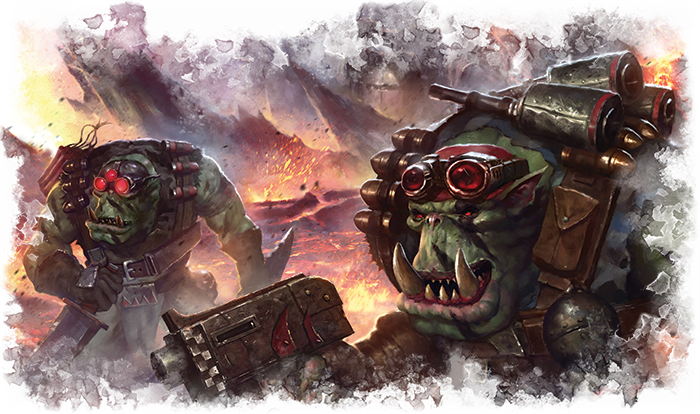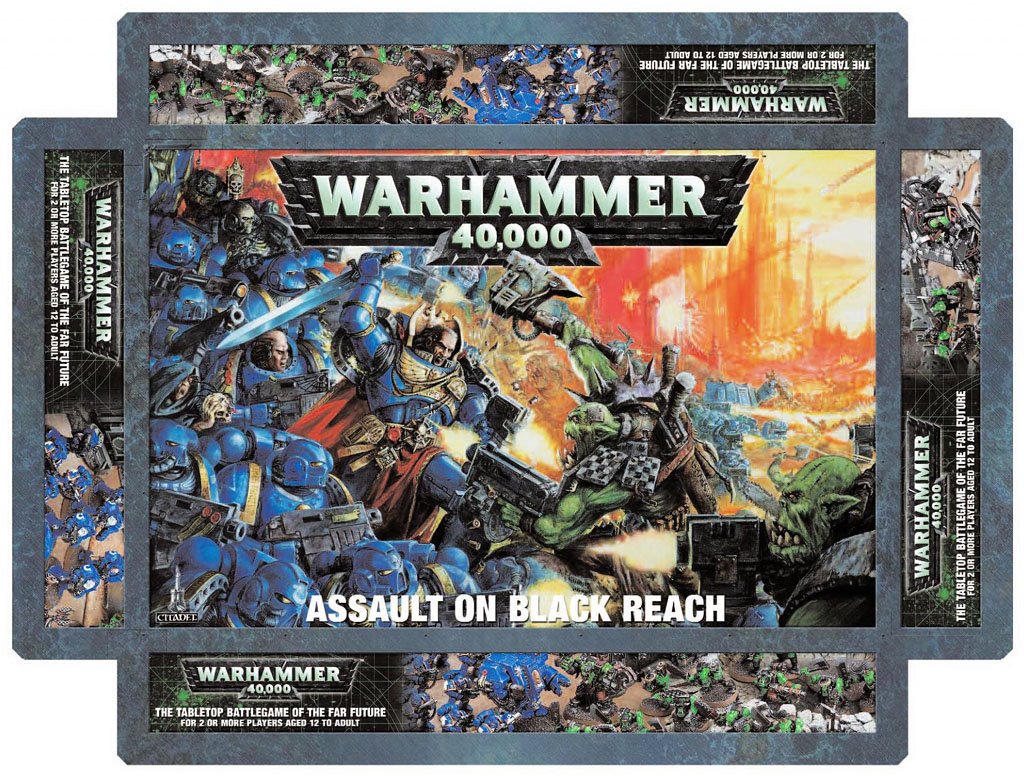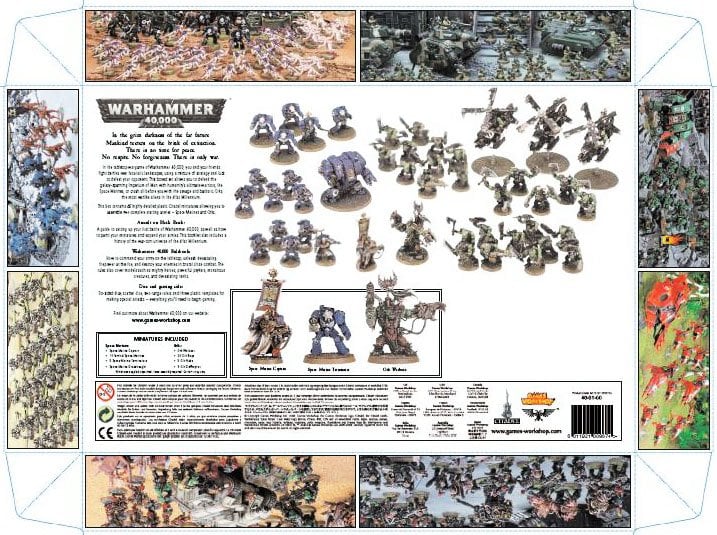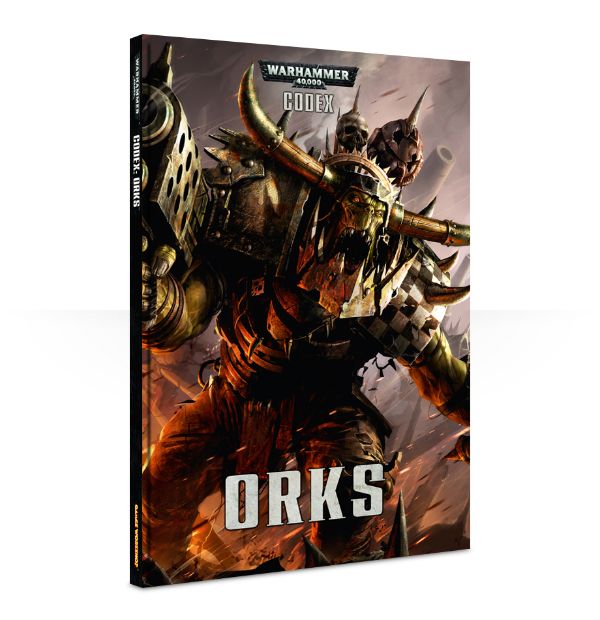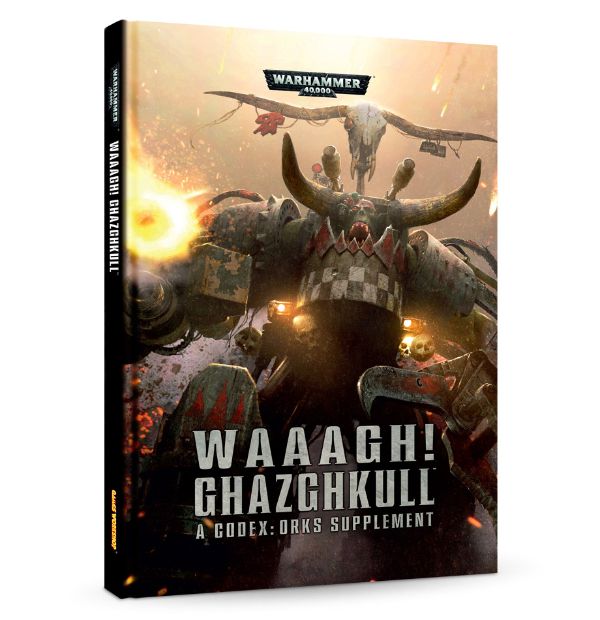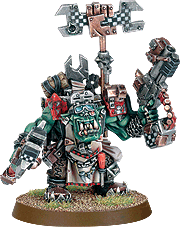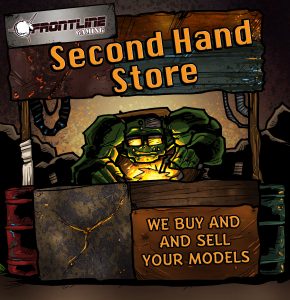It Ain’t Easy Being Green: Orks Evolution in 40k


Today we look at how the Orks have changed over the course my time in 40k.
Michael Corr here. For more reviews, analyses and battle reports, check out the Tactics Corner.
Welcome to the latest in my series of articles looking at the evolution of different aspects of 40k. This time I will be looking at the evolution of the Orks from the 2nd edition codex to the current state of the army as 7th edition comes to an end. I am not planning to cover every aspect of the codex and army, but will look at general trends in how the greenskins have evolved over the course of the 6 editions to become what they are today (settle in, this is a long one!).
The Orks have come pretty far in the many years they have been in 40k, developing their own flavour and playstyle over the course of many editions. Orks are generally regarded as one of the most “fun” armies available to play. Much of this comes from the randomness inherent in their rules over the years as well as being one of 40k’s best armies when it comes to kit-bashing and conversion work, especially on their vehicles. Unlike the standardised tanks of the Space Marines and Imperial Guard, no two Ork vehicles in an army need ever look the same.
I first started with the Orks with the release of GorkaMorka (more on this to come), building up my mob and fighting with my friend’s mob for many glorious battles. This gave me my first taste of kit-bashing when I decided to convert one of my wartrakks with parts from a toy car in order to give the vehicle an increased transport capacity (in GorkaMorka, how many Orks could ride in a vehicle was determined by how many Ork models would actually physically fit on the model). My first forays into using Orks in 40k came midway through 3rd edition when the same friend decided to sell off his starting Ork army and I bought it. This gave me a warboss, two large mobs of unpainted boys and a few vehicles with which to start my warband. I have been playing Orks ever since then. They have remained one of my favourite armies, and though they have fallen on hard times in more recent editions, I still have a special place for them in my 40k collection.
While researching this article, I came across another nice article on the development of the Orks from Rogue Trader to 3rd edition. This is well worth a read for anyone looking for information on the earlier years of the Orks.
Second Edition Ork Codex (1994-1999)- Almost Human
The Ork army in second edition was a very different beast to what you might consider a typical Ork force nowadays.
A basic Ork boy cost around 12 points per model and his stat line was quite different to what it has now been for several editions. An Ork boy essentially had a human statline, but with toughness 4 and initiative 2. This meant that an Ork had comparable combat and shooting prowess to an imperial guardsman, but was a bit tougher and a little slower. As a result of this, Orks could put out a fair amount of firepower in the shooting phase, comparable to Imperial Guard infantry. The basic Ork boy was armed with a boltgun or a bolt pistol and axe.
Units in the Ork army were arranged into mobs based on the major Ork clans. At least 25% of the army’s points cost had to be spent on “Mobs”. These consisted of Nobz mobs, Blood Axe commandos, Freebooter pirates, Bad Moons mobs, Blood Axe mobs, Deathskulls mobs, Evil Sunz mobs, Goff Mobs, Snakebite mobs, gretchin mobs and snotlings. Mobs were generally between 5-20 models and the type of mob gave the unit access to different types of wargear and weaponry. For example, Evil Sunz mobs could be mounted on Warbikes, while any member of a Deathskulls mob could carry a heavy weapon or kustom combi-weapon (other mobs were generally limited to one heavy weapon per mob).
The army also featured an expanded list of HQ units that could lead the army, including a Warboss, Weirdboy, Mekaniaks and painboys.
They also had access to a vast array of support weapons. This included artillery pieces such as Pulsa Rokkits, Squig Catapults and more familiar vehicles such as a Dreadnought, buggies and bikes.
The Ork army in 2nd edition was much more fractured, with lots of different mobs making up the army with lots of different colour schemes. This could lead to an eclectic looking force. It was possible to build up different types of armies as the klan mobs were part of the “core” section of the codex. You could take a bike-mounted Evil Sunz army, Deathskulls army loaded with heavy weapons and a Blood Axe army with “borrowed” Imperial vehicles.
The codex included a variety of special characters including Ghazghkull, Mad Doc Grotsnik and Wazdakka Gutzmek (who wore Mega Armour and rode a warbike!).
The army also included the more unusual elements of the Orks, including Weirdboyz and Snakebites riding psy-boars. Ork mega-armour also included a “built-in” 4+ feel no pain roll and the Ork army could also include Ogryns.
The Ork Tactiks section in the book included the advice; “the troops in an Ork warband are very specialised and need to be used in combination in order to be effective”. Ork mobs were often used in various combinations with a mix of heavy weapons and combat troops. Using a gretchin screen was a very popular tactic in second edition (as you had to shoot at the closest enemy unit).
The concept of the Waaagh as a great Ork call to war was also discussed in the codex.
As was mentioned above, due to all the different mobs and their unique looks in 2nd edition, it could be hard for an Ork army to have a cohesive look on the battlefield. There were still a few developments to come for the Orks before the 3rd edition of 40k was released.
GorkaMorka (White Dwarf 214)
While not a game directly related to 40k, I feel that GorkaMorka represented another important stage in the evolution of the Ork race in the 40k universe.
For those that don’t know, GorkaMorka was a game that Games Workshop released in 1997 that featured battles between different mobs of Orks stranded on a desert planet. The game used many aspects of the 2nd edition 40k rules as its basis, as well as including an experience points and mob progression system as had been seen with Necromunda. The game also introduced ramshackle Ork vehicles called Trukks and Trakks into the game, which were a lot of fun to use.
I remember getting the game for my birthday one year and having an absolute blast with it for a long time. I recently dug out all my old rulebooks for it, as well as tracking down the card fort that came with the game to use in my 40k games. I will need to get a new campaign run with it at some point in the future.
The aesthetics of Orks in the game were different from what had come before. In line with the background of the game, the Orks and their vehicles took on a more feral and ramshackle appearance, no longer wearing uniforms, but going shirtless or wearing more “slap-dash” uniforms and armour.
The Orks were also no longer armed with Imperial weapons such as Boltguns, bolt pistols, heavy flamers and heavy bolters, but now went to war with Shootas, Sluggas, Scorchas and Big Shootas.
The stat line of the Orks remained unchanged, but the changes to the look and ethos of the Orks and their armaments that began with GorkaMorka can still be seen in the current Ork range. For me, the change in the style of the Orks with GorkaMorka was a big influence on how the Orks were evolving as a race in the 40k universe, making it an important milestone for the race. Not only that, but it was a damn fine game to boot.
Third Edition Orks (1998-2008)- As Simple as an Ork
The third edition of 40k saw a massive upheaval to the core ruleset, and brought about major changes to all armies in 40k. Such massive change allowed GW to completely redesign how different armies played and re-do their entire miniature range. The changes that were first seen in GorkaMorka and hinted at with Last Stand at Glazer’s Creek continued for the Orks, where the third edition rulebook began to completely reinvent the way the Ork army looked and played.
The designers notes for the Orks highlight some of the changes that were made to the race:
“In the course of putting together the army lists for 40K we took the opportunity to re-define each of the armies to make them more characterful and a bit more balanced in relation to each other. When I worked on that Ork list I was strongly influenced by my experience of what Ork armies were like when put together using the old Ork codex. I felt that they tended to be very ‘bitty’, with lots of small mobs from different clans, usually armed to the teeth with meltaguns and plasma guns and hiding behind huge screens of Gretchin cannon-fodder. Close combat was something only indulged in by Boarboyz or occasionally Stormboyz, and most of the damage the army inflicted was by shooting, particularly with a selection of grotesquely effective Squig Katapults, Shokk Attack Gunz and other weirdy weapons.
This didn’t seem right to me at all. Orks are supposed to be tough, brutal alien warriors which are always depicted as attacking in big, ferocious mobs which threaten to overwhelm the enemy in close combat. Having a handful of Orks in the army skulking around at the back and shooting didn’t seem right.” Andy Chambers, Designer notes for Codex Orks, White Dwarf 235.
Third Edition Rulebook
The third edition 40k rulebook featured army lists for all of the major races in the 40k universe and showed some big changes were afoot for the Orks. New special rules were introduced to give a new flavour to the army and the army list for the Orks saw big changes too.
Special Rules
The first major change was that the “Feral Orks” statline seen above became the norm for the army. The basic Ork boy was now WS4 and BS2 (and has been ever since). This signalled a change in philosophy for the Ork race, making them more of a combat-centric force than had been seen previously.
The concept of “Mob Rule” was also introduced. This was similar to the theme for the Skaven in fantasy, where Orks were more confident in larger numbers. The rule was that if an Ork mob failed a morale check, they could then ‘check size’ to see if the mob would keep fighting. The player would roll 2D6- if the number was equal to or less than the number of Orks in the mob, then the test was passed. This obviously encouraged players to take large mobs of Ork boyz, as units over 12 models strong would not flee from shooting casualties or from combat.
The concept of “mobbing up” was also introduced in the 3rd edition rulebook. This gave the Orks the ability to merge fleeing Ork mobs with any mobs that were behind them, allowing the remnants of the mob to get back in the fight.
Ork wargear was also brought into line with what was seen in GorkaMorka; boltguns were replaced by shootsas and bolt pistols were replaced with sluggas. Ork heavy weapons (big shootas and rokkits) also became assault weapons, allowing the Orks to fire as they advanced towards the enemy and keeping with the philosophy of a more assault-oriented race.
The rules for Kustom Force Fields were also detailed, introducing a 5+ invulnerable save for all models within 6″ to help protect Da Boyz as they advanced on the enemy army.
Army List
The army list for the Orks also saw big changes to represent the new direction for the greenskins.
There was only a single HQ choice for the Orks in the 3rd edition rulebook. The Ork army had to be led by a Warboss. As the toughest Ork in the army, he had the option to take a bodyguard made up of Nobz, Mekboys, Mad Doks and Grots.
The core of the Ork army was Ork Shoota Boyz (8 pts each) and Ork Slugga Boyz (9 pts each). The squad size was also increased from 5-20 models in 2nd edition to 10-30 models in 3rd edition. The new special rules and mob size encouraged players to take larger mobs compared to the small, discrete mobs seen in 2nd edition. The new army layout and style would also allow players to take more coherent armies, as the requirement to make up an army using mobs of different Klans was now gone (in fact, the concept of Klans in army selection was severely reduced).
The army list appendix included rules for adding Boarboyz and Weirdboyz to your army. It also included a Kult of Speed that gave the option for a mounted force. Any troops choices in the army had to be selected from the fast attack section (warbuggies/wartrakks, warbikes and wartrukks with boyz). In addition, the Warboss had to be mounted in a trukk and no heavy support or elite choices were allowed with the army.
The appendix also included rules for fielding feral orks, allowing the introduction of Boarboyz and Weirdboyz to the army, but restricting the use of more technical units such as Mega Armour, Mekboyz, Stormboyz, etc.
Mega Armour now gave Orks a 2+ armour save and a built-in shoota and power claw, but forced the wearer to move as if in difficult terrain (to represent the slow and clunky nature of the armour).
The release of 3rd edition 40k and the re-invention of how the Ork race played on the table was the beginning of the shift for the greenskins, that would continue in the subsequent releases for this edition of the game.
Third Edition Ork Codex (1999)
The Ork codex was the 6th to be released in third edition (7th if you include the free Assassins book that White Dwarf gave away), coming out almost a year after the release of 3rd edition itself.
The new codex sought to expand the special rules and army list for the Orks to make the army work better in third edition.
“Over the course of playing battles with the Orks and listening to feedback, two things became apparent. Firstly, the Orks’ low Initiative meant that they often spent most of the game legging it across the battlefield and getting shot up, only for the survivors to get killed in close combat before they had a chance to fight back (boo, hiss). Secondly, when the Orks fought Space Marines, ordinary Orks couldn’t scratch the Emperor’s finest, despite having huge number of attacks” Andy Chambers, Designer notes for Codex Orks, White Dwarf 235.
Special Rules
To deal with the first issue, a new “The Power of the Waaagh!” rule was introduced. Any Ork mob charging into combat took a mob rule test (rolled 2D6 and compared to the size of the mob). If the number rolled was equal to or greater than the number of Orks in the mob, the unit doubled its initiative value until the end of the assault phase. This rule again encouraged the player to have large mobs of Orks in the army, as they would be striking at the same time as Space Marines thanks to the power of the Waaagh!
The rules for Choppas were also introduced to help the Orks deal with strong armour in combat. A model that attacked with a choppa limited their opponents armour save to no better than 4+ in close combat. This new rule saw Space Marines and Terminators become more vulnerable to certain Ork mobs, as their powerful armour became a lot less durable against the Orks. To balance this out, the Orks lost access to standard power weapons in 3rd edition, have to rely on the slow striking power claws to completely negate the enemy’s armour in combat.
A new type of weapon was introduced to further help the Orks in both the shooting phase and close combat phase; the Burna. The Burna was a flamer that could instead be used as a power weapon in the close combat phase. Up to three models in a standard Ork mob could be armed with a Burna, meaning a massive 9 power weapon attacks on the charge.
These new rules helped to make the Orks a potent assault force. The Orks were still vulnerable to enemy firepower with their weak armour and could still be neutered by being assaulted by the enemy, but once a large mob got into combat, the combination of high initiative and high volume of attacks and the save reduction powers of the choppas made them a very powerful foe in the assault phase.
The Army List
One change that occurred in the simplification of the armies in third edition was that the Orks lost a lot of the wackier elements that made the army so unique in previous editions.
Gone were the Boarboyz, Weirdboyz, Squig Katapults and Shokk Attack Gunz, to name a few.
The army did, however, see an expansion on the army list presented in the 3rd edition rulebook. The HQ section was expanded from just the Warboss to include Big Meks and Painbosses. This allowed the Big Mek to carry a Kustom Force Field and use it to protect other units (only the Warboss’ bodyguard could take one in the rulebook army list).
Several new units were introduced to the army, including Flash Gitz, Burna Boyz and Tankbustas. The last two units were in the troops section and gave the Ork player tools to deal with armour and tanks, respectively.
Some of the craziness of the Ork army was kept through the Lootas, Battlewagon and Looted Vehicle rules.
Lootas allowed the unit to take weapons from a variety of different squads in other codices including tactical squads, devastators squads and Imperial Guard infantry squads. This gave the Orks access to more powerful weapons (albeit at the lower BS of the Orks), but had the risk of the weapons harming their own unit when a 1 to hit was rolled.
Looted Vehicles were also another fun addition to allow the Ork player to show off their conversion skills and take more powerful vehicles in the army. The choice of vehicles included a Rhino, Razorback, Land Raider, Chimera and Leman Russ Battle Tank. One of the most popular choices was a Basilisk. This gave the Ork player a very powerful gun with S8 and AP3 and the low BS of the Orks was negated as no roll to hit was required.
The codex helped to further develop the Orks as a strong close combat race, with additional special rules and units to help them in that regard. The weaknesses of the Ork army came from the light armour of their transport vehicles and difficulties in dealing with enemy vehicles. Much of the more unusual elements of the Orks from 2nd edition had been curtailed or removed from the army. Clans were removed entirely and the Feral Orks and Kult of Speed army lists from the 3rd had also been removed, though some of these aspects would be added back in later supplements.
Da Red Ones go Fasta- Codex: Armageddon (2000)
In the year 2000, Games Workshop released Codex: Armageddon as a supplement that allowed players to field some new armies to coincide with their worldwide campaign battling over the fate of Armageddon.
Amongst the new forces was an army list for fielding an Ork Kult of Speed; an all-mounted, fast moving Ork army. This was a nice contrast to the footslogging forces that you were normally required to build with the 3rd edition Ork codex.
The army required all infantry to be mounted in a transport of some variety and moved units around their respective slots in the Ork codex (Troops, Fast Attack, etc.) to create a new thematic force of Ork raiders. Units such as Trukk boyz, warbikes and warbuggies were moved to the Troops section and other troops units were given the option of purchasing transport vehicles to be included in the army.
Several new units were introduced, including Nob Bikers, Deth Koptas and a fighta bomba bombing run.
The army also gained some new special rules to reflect the way the force should play. Speed Freaks units fell back towards the nearest friendly vehicle, rallying and embarking in the vehicle if they got within 2″ of it. This rule allowed your units to rally even if they were below half strength or close to the enemy (which prevented units from rallying back in 3rd edition). This meant that your units could always rally as long as you had some vehicles remaining. This gave them some bonus to the army where the smaller size of the Ork units could make it more difficult to get your Mob Rule or Power of the Waaagh! rolls.
The army was also allowed to start rolling for reserves from turn 1 to represent the fast moving nature of the army.
The supplement gave players a new way of fielding an Ork army, rather than just using the greenskin horde that the Ork codex encouraged. I remember using the army once or twice in smaller points games (as I simply didn’t have enough trukks to field a larger force). It was a lot of fun and provided different tactical options to simply moving towards the enemy in large blobs.
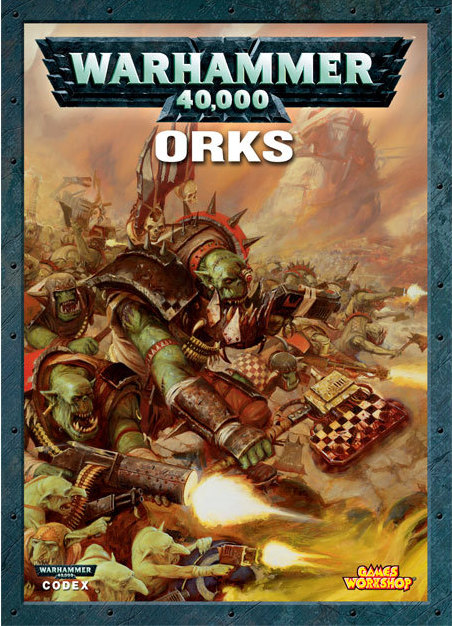
4th Edition Orks (2008-2014)- Bringing Back the Crazy
The release of the 4th edition codex saw the Orks return with brand new rules, brand new kits and the return of the Oddboyz. One of the key aspects of the new codex was to increase portrayal of the Orks as a horde army.
“We’ve always portrayed the Orks as being a horde army, having masses of warriors that pour forward in a big green tide all shouting at the tops of their voices. Unfortunately that didn’t always work so well on the battlefield and that’s something we’ve really addressed in the new codex. We wanted to make the horde army approach just as devastating as the background suggests.” Phil Kelly, Da Green tide (Ork codex designer notes), white dwarf 337.
This goal was achieved by a points reduction, as well as the introduction of several new special rules. The price of an Ork boy was reduced from 9 pts to 6 pts in the new codex, allowing players to field larger mobs of Orks for cheaper than before.
The new Orks also benefited from the Waaagh! and mob rule special rules, as well as gaining Furious Charge.
The Waaagh! Special rule was introduced to represent the blood lust of the Orks in battle. Once per game after the first turn, the player could call the Waaagh! This gave all Ork units the Fleet of Foot special for the duration of that turn. This allowed the Ork units to run an additional D6″ in the shooting phase instead of firing a weapon. In fourth edition, units were also allowed to charge after this fleet move, meaning that the Ork units had greater chance of closing range with enemy units and assaulting them. However, on a roll of a 1, the unit would squabble and one model from the unit would take a single wound. This did not prevent the unit from assaulting as normal.
The Orks also gained the Furious Charge special rule. In fourth edition, this added one to the strength and initiative of a charging unit. This meant that the charging Ork unit was initiative 3 when assaulting. This was lower than the initiative 4 that could be gained in the 3rd edition Codex, however, the Ork units gained a point of strength on the charge that they did not previously have in the last edition of the Codex.
“Furious Charge effectively replaces the choppa rule’ says Phil. ‘ I’ve never been a fan of the choppa rule, as it modifies an armour save, which goes against one of the design tenets of the Warhammer 40,000 game. Also, it was very effective against heavily armoured foes, such as terminators, but didn’t make any real difference when facing say, a guardsman. This made the rule very counterintuitive. Furious charge gives a mob of Orks some punch on the critical first round of combat no matter which foes the Boyz are charging.” Phil Kelly, Da Green tide (Ork codex designer notes), white dwarf 337.
The new codex also saw a reworking of the Mob rule special rule. It worked in a similar fashion to the previous rule, but with a few important differences. The new mob rule meant that units of Orks that featured 11 or more models counted as Fearless. This meant that the unit could now suffer additional casualties as a result of losing combat. In addition, the Ork mob could substitute their leadership value for the number of orcs in the squad. This meant that rather than having to take both in a morale check and a mob size check as in the previous edition, the unit simply made a single check and could choose to substitute their leadership value.
This was a very popular rule amongst Ork players, and became even more popular when the Green Tide formation was introduced to the army. This allowed players to field a squad of Orks 100 models strong, meaning that the unit had to take at least 90 casualties before they had to take a morale test.
The other big change for the fourth edition codex was the re-introduction of some of the zanier elements of the Ork army from the second edition Codex. This included the addition of Mekboyz (complete with Shokk attack gun), Weirdboyz and Painboyz.
The Mekboy could be armed with either a Kustom Force Field or Shokk attack gun. The Kustom Force Field provided all units within 6″ of the Mek with a 5+ cover save. Given the cover rules in 4th edition, if the majority of the unit was in the Kustom force field’s bubble, then the entire unit could claim the cover save. This made it possible for a single Mek to protect a large number of units through careful unit positioning. In addition, vehicles within 6″ counted as obscure targets, giving them a 4+ chance of downgrading a penetrating hit to a glancing hit. Again, this allowed the Mek to protect a large number of vehicles with careful unit positioning.
To me, the return of the Shokk attack gun added the return of a fun element of the Ork army. Much like the current codex version, the strength of the attack was determined by rolling 2D6. If a double was rolled, the player would consult a chart to determine the effects of the shot. This could range from the gun exploding, to the firer being hurled into combat with the target unit, to the models hit being utterly obliterated.
One oddboy that did not benefit from this randomness was the Weirdboy. The Weirdboy had six possible psychic powers and would have to randomly determine which power could be used each turn. Some of these abilities where quite potent, however, the randomness of determining the power each turn made it difficult for players to effectively plan strategies involving the Weirdboy. I was always disappointed when using the Weirdboy in my games, as the random nature of generating the powers each turn meant you needed to be lucky to get the right power at the right time.
Another popular addition to the Codex was the change in the rules for Lootas. Previously, the Lootas had been armed with Imperial versions of weapons. Coupled with the low BS battle of the Orks, I found these units were quite ineffective. The new version of the Lootas were now armed with Deffguns, giving them D3 S7 shots in each shooting phase. A full unit of Lootas could potentially put out 45 S7 shots, making them a potent source of firepower for the Ork army. I found them to be highly effective in my games and a real pain for many of my opponents.
Tankbustas we are also present in the Codex, but were hampered by the Glory Hogs special rule. This required the unit to shoot and/or assault an enemy vehicle if there was one in Line of Sight, regardless of the range. In my opinion, this hampered the ability of the controlling player to effectively utilise this unit as they could be easily counted by your opponent.
As well as a cost decrease, units of Ork boyz also saw a couple of changes. Units now no longer had access to Burnas in the squad, but any mob below 12 models now had access to a Trukk as a transport vehicle. Previously, Trukk Boyz where restricted to a fast attack slot, but the new codex allowed any troops choices to take the place of trukk mobs. This allowed players to easily build a “Speed Freaks”-type army using the standard codex, allowing for more variety in the armies seen.
Assault on Black Reach (2008)
The Orks also received a big boost with the release of the 4th edition boxed set- Assault on Black Reach. This set once again saw the Orks return to the “starter game” for 40k, as they had been in 2nd edition. This new set saw the introduction of a plastic Warboss, plastic Nobz and a new plastic Deffkopta.
These great new models made it easier to start an Ork army for cheaper, or to add to an existing Ork force. Having Ork models in the starter boxed set made it easier for players to start the army, and I imagine further added to the popularity of Orks in 4th edition.
Not long after the release of Black Reach, the Ork army saw new reinforcements in the form of all new plastic kits.White Dwarf 349 saw the release of a host of Ork special characters, including Boss Zagstgruk, Kaptin Badrukk and Boss Snikrot. We also got an update of the Stormboyz and Nobz kits. Biggest of all, a new plastic Battlewagon was released. Previously, most Ork players were forced to construct their own version of the mighty Battlewagon from whatever they had to hand (just like good Lootas should!), but now they had a brand new kit to bring death and destruction to their enemies.
Seventh Edition Codex (2014-Current)- Mob Rule Blues
The Orks were the first to receive the 7th edition treatment to their codex in the new edition of the game. Many players were hoping for a toning down of the power levels of the armies in 40k, and the changes to the Ork codex and a few subsequent codexes seemed to be suggesting that this would occur.
Angering the Mob
One of the biggest changes to Orks in 7th edition (and one of the most lamented by players) was the change to the Mob Rule.
Since 3rd edition, the Mob Rule had provided Orks with a way of essentially gaining Fearless from having a large number of Boyz in each mob. The new mob rule gave Ork players a chart to roll on any time a mob failed a Morale check or pinning test, with the number of Orks in the mob or the presence of a character in the mob having an effect on the test.
On a roll of a 1, the unit passed the test if they were engaged in combat, otherwise they failed it. This was an ok result for the mob, assuming they were in combat. Otherwise, the unit had to fall back or be pinned and spend at least another turn unable to advance on the enemy or assault. On a 2-3, the unit suffered an additional D6 S4 casualties if the unit contained a character. If there was no character, the unit failed the test. While this rule was useful for heavily armoured units such as Meganobz, for normal Boyz mobs or specialist mobs such as Lootas or Tankbustas, it just caused more casualties on the unit. Given that it was possible to have to take 2 or 3 morale tests a turn, this could be pretty brutal on any Ork mob in your army. The kicker of this was also that the casualties were at S4, not the base strength of an Ork. There were many situations where you would hit your own squad harder than you could hit your opponent’s squad! The final result was suffering D6 S4 hits if you had over 10 models in the mob. If you had less than 10 models, you failed the test.
While this rule was nice and thematic for the Orks, it took an already struggling army and made them a little bit worse. I don’t think the old Mob Rule versions were too overpowered in the game to undergo such a drastic change. Perhaps there were too many Green Tide formations being used that were very difficult to take out thanks to their large size.
One bonus that the Ork army got in the 7th edition codex was a pseudo-Fleet roll called ‘Ere We Go. This allowed certain mobs to re-roll a single die from a charge roll, giving them a better chance of successfully assaulting the enemy army. Added to the Waaagh! special rule, allowing mobs to run and then assault on the turn the Waaagh! was called, and you had some nice bonuses for getting into combat.
Top Heavy
One of my other issues with the 7th edition codex was that the number of HQ units grew in the army. While this was good for variety, it no longer allowed you to take a Warboss, Big Mek and Painboy in a single CAD. One bonus of making the Painboy its own HQ unit though, was that he could now be added to any unit in the army to provide them with a Feel No Pain roll, not just a Nobz mob.
Another nice change was that the Kustom Force Field went from a 5+ cover save to a 5+ invulnerable save. Given the high volume of Ignores Cover fire accessible in 7th edition, this was a nice way to give the Orks a decent save against shooting. However, the change came with the caveat that only MODELS in the 6″ range, not UNITS were affected. This stopped players from gaining the save by only having half the mob in range and being able to provide protection for multiple units with careful positioning.
Getting More Rules
Seventh edition also saw the release of new supplements for the Ork army. Waaagh Ghazghkull and Sanctus Reach: The Red Waaagh provided new rules and Relics for the Ork army. I never purchased these supplements, so am not too aware of what they added to the Ork army. I didn’t feel the need to have to buy a bunch of new books just to make my army somewhat playable and competitive. If you have any thoughts on these books, please share them in the comments below.
Looking Forward
A new edition of 40k is apparently due very soon. Much like the change from 2nd edition to 3rd edition, this new version of the game looks to be a dramatic departure from what has come previously. Entire rules and armies are being re-designed from the ground up.
This makes it an exciting time to be playing some of the “lower tier” forces in the current game, as a complete re-design will hopefully bring them back to a comparable power level with the other races in the game. I, for one, am looking forward to seeing how the Orks fare.
As I said above, Orks are one of my favourite armies in the game. They are a lot of fun to play and give a huge variety for players to show customisation and their own unique style in the game. As you can see, they have been through some huge adjustments over the past couple of decades and should hopefully continue to grow and prosper in the coming years. Now, if you’ll excuse me, its time to sharpen my Choppa and load my Slugga.
~The big Waaagh! is coming this summer and I want to be ready for it!
And remember, Frontline Gaming sells gaming products at a discount, every day in their webcart!

